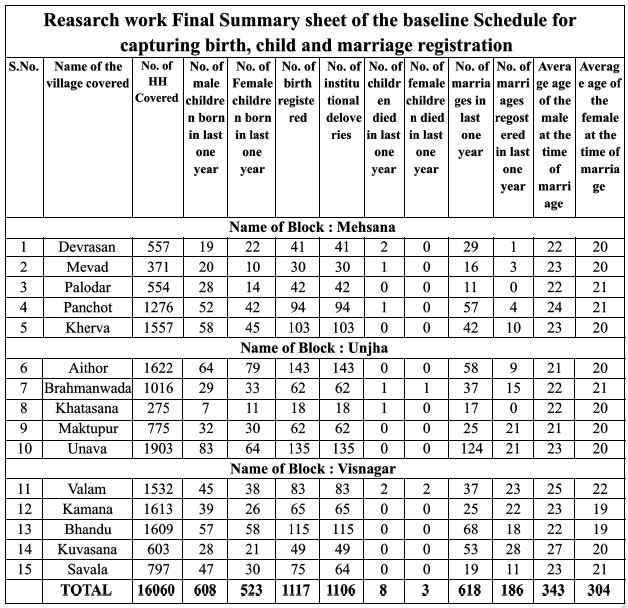 1. THE
ATTITUDE, KNOWLEDGE AND BEHAVIOR
OF THE SOCIAL, POLITICAL AND RELIGIOUS
LEADERS TOWARDS THE PEOPLE LIVING WITH
HIV/AIDS.
1. THE
ATTITUDE, KNOWLEDGE AND BEHAVIOR
OF THE SOCIAL, POLITICAL AND RELIGIOUS
LEADERS TOWARDS THE PEOPLE LIVING WITH
HIV/AIDS.
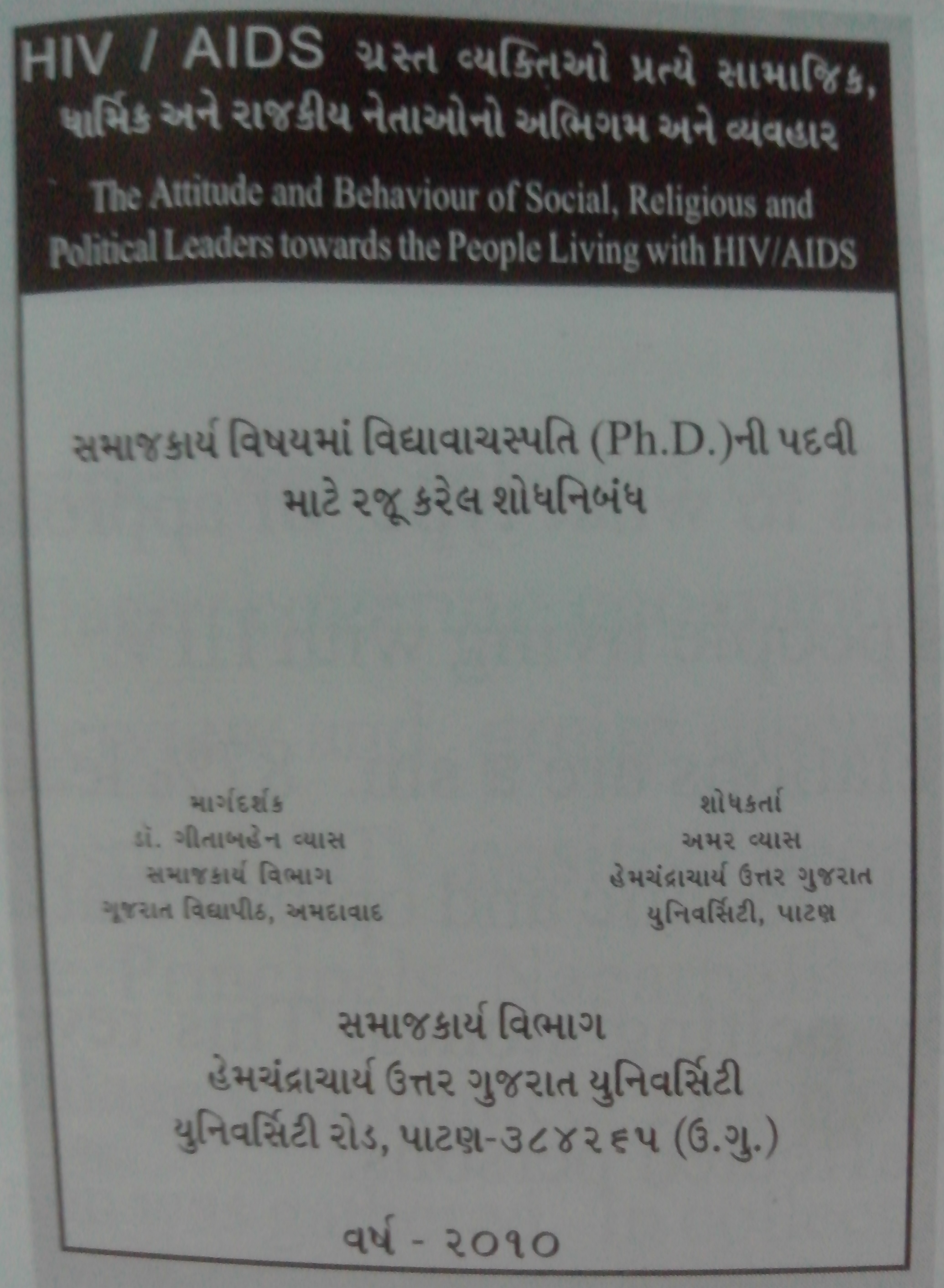 (Based
on research report by Dr. Amar Vyas. )
(Based
on research report by Dr. Amar Vyas. )
Very important findings have come up while
examining the attitude, knowledge and behavior of
the social political and religious leaders.
The instant research is carried out interviewing
150 social political and religious leaders of 9 Taluka
of Mehsana district in Gujarat State. The personal
interview and qualitative methods were applied. The
information is gathered by multiple-approach which
has provided many lessons to understand.
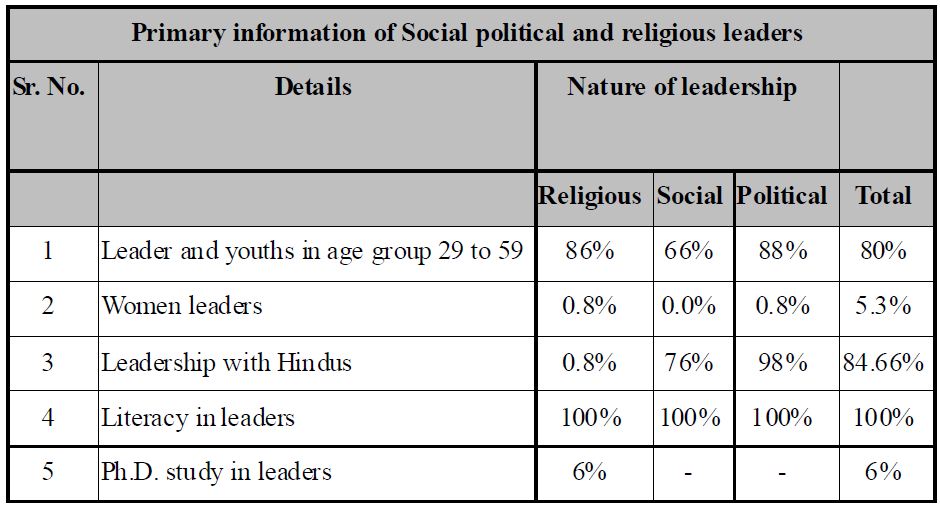
• Knowledge :
An attempt is made in the instant research to examine the knowledge of the
religious, social and political leaders with a view to enhancing acceptance of HIV/
AIDS affected persons as the patients of incurable diseases of kidney, heart and
Cancer are accepted in society in general. The main finding of the study is that a
majority of the leaders have either no knowledge of the disease or have incorrect
information about it. All the leaders interviewed knew that sex with an HIV
affected person causes the spread of the disease but only 60% of the leaders
agreed that condom should be used during sex. 92% religious leaders think that a
person who gets AIDS from sex worker is a sinner.
• Approach :
It has been tried differently to examine as to what type of approach religious,
social and political leaders have towards people living with HIV.
93.3% leaders think that extra marital relations are a sin. 87% leaders are
having fanatic attitude. 2% leaders are extremely fanatic and opined that a sinner
should be half burried in soil and be killed by pelting stones. This reveals the
attitude of the leaders of society towards HIV affected persons.
• Behavior :
If we look at the behaviors of the leaders towards HIV affected persons,
58% leaders have never met people living with HIV. Hence question does not
arise to check their behavior. 42% leaders have met HIV affected persons. The
highest number is of religious leaders. 89% leaders have become helpful to HIV
affected persons.
The leaders having capacity to affect behavior of the common people by
changing the value system of the society were given correct information of HIV/
AIDS. They were ready to become helpful and those who were given opportunity
tried help HIV affected persons.
Thus the entire research resulted into action research and has become useful
for future experience.
2. A study to know the increasing ratio of HIV in Mehsana district.
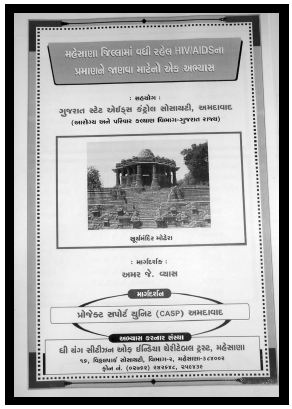 The HIV
ratio is 1% to 1.5% in general population as
per the sentinel surveillance report in Gujarat. An effort
is made in the instant research to check as to why such
high ratio is visible in Mehsana district.
The HIV
ratio is 1% to 1.5% in general population as
per the sentinel surveillance report in Gujarat. An effort
is made in the instant research to check as to why such
high ratio is visible in Mehsana district.
• Research Area :
The research study is made on the basis of qualitative
and quantitative method in 9 Talukas of Mehsana
district.
• Research Method :
During research 4 villages of 9 Talukas of Mehsana
district were selected on the basis of flow of HIV STI and RTI cases. Other
villages covering geographical areas of Taluka were also selected. The personal
interview and group discussions were held. Doctors, of PHC, RHC CHC Civil
Hospital, HIV positive people, Sarpanchas, leaders, members of Health Committee,
Principals, Nagarpalika President, Corporator, Police, Talati, members of the
village Committee, Pan parlours, general store etc were contacted and information
was gathered. In collection of information, Annexure F.G.D. interview method,
observation and case study method were used.
• Findings :
1. Large scale out migration to different cities for different professions from
Mehsana district.
2. Mehsana district has a business potential for various industries and therefore
people come from other States and stay alone.
3. The ratio of M.S.M. and C.S.W. is seen in rural areas of the district which has
a connection with cities.
4. In the rural and urban areas there are instances of internal sexual relations
where condom is not used.
5. HIV ratio has gone up in the district due to low female ratio and also due to
some castes preferring marriages at later age.
6. In Pilgrim age places such activities have increased so far.
3. The ratio of M.S.M., F.S.W. and client in Mehsana city, network and
study to have information as regards HIV/AIDS in them. (Year 2008)
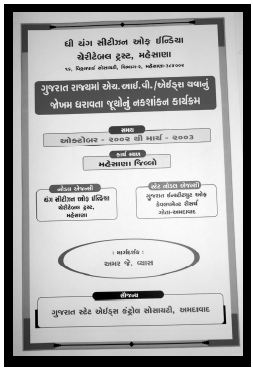 The
HIV/AIDS ratio of 1% to 1.5% is seen in Mehsana district The disease is
shifting from urban to rural areas. Many reasons have
come up while collecting information about this: growing
ratio, mainly, the falling ratio of girl child, out-migration,
in-migration etc.
The
HIV/AIDS ratio of 1% to 1.5% is seen in Mehsana district The disease is
shifting from urban to rural areas. Many reasons have
come up while collecting information about this: growing
ratio, mainly, the falling ratio of girl child, out-migration,
in-migration etc.
• Findings :
Young Citizen Team has undertaken a study to have information
about HIV/AIDS and that of the ratio and network
of M.S.M. C.S.W. clients in Mehsana city. The information
was gathered from different passive and active
groups. This revealed that the ratio of brothel based C.S.W. is high, which
requires to be taken into account.
4. Mapping programme of the groups prone to HIV/AIDS in Gujarat
State.
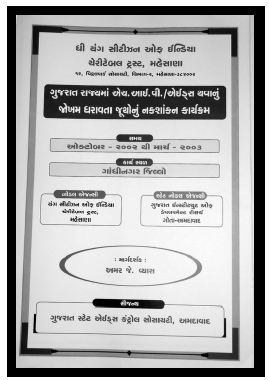 The
mapping work of the group prone to HIV/AIDS in
Mehsana and Gandhinagar districts for the period October-
2002 to March-2003 was completed by the Young Citizen
The
mapping work of the group prone to HIV/AIDS in
Mehsana and Gandhinagar districts for the period October-
2002 to March-2003 was completed by the Young Citizen
Mehsana as per guidance of Gujarat Institute of Development
Research, Gota, Ahmedabad as State Nodal
Agency, courtesy Gujarat State AIDS Control Society.
Findings of Mehsana district :
During Research, information was collected from 424 key
informants in 9 Talukas of Mehsana district Out of 424, 207 were decided as site
suspected. 136 sites were validated and rejected. A risk accepting group of 1214
has come Forth from a Taluka on the basis of sites validated by the Young Citizen.
5. Findings of Gandhinagar district :
In mapping work of Gandhinagar district total key informants were 129, in 4
Talukas. Total suspected sites were 52. 49 sites are validated and 3 rejected.
This mapping work has revealed many important things. In these two districts
there is a potential for much work on HIV/AIDS.
6. Research Report regarding registration of Birth death and marriage.
The Young Citizen has carried out research work with 16060 families during
the period from 9th June-2009 to 31st May 2010 In the target area to check the
progress of the ongoing work in 15 villages of Mehsana, Visnagar, and Unjha
Blocks Project Area. Empowering the Community valuing the girl child project is
going on in Mehsana district with the help of U.N.F.P.A. Women Power Connector,
New Delhi. The information regarding birth, death and marriage registration
was collected.
